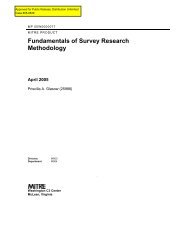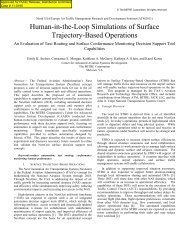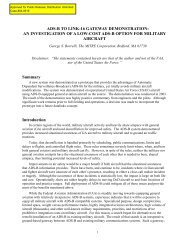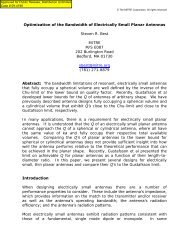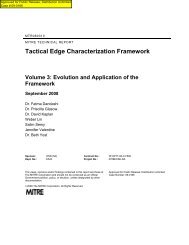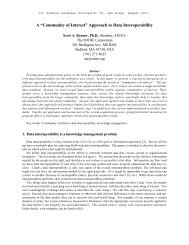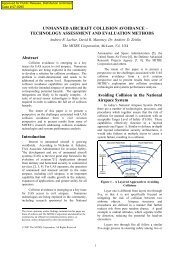Incremental Capacity Upgrade of Exisitng Fiber Optic Links - Mitre
Incremental Capacity Upgrade of Exisitng Fiber Optic Links - Mitre
Incremental Capacity Upgrade of Exisitng Fiber Optic Links - Mitre
Create successful ePaper yourself
Turn your PDF publications into a flip-book with our unique Google optimized e-Paper software.
<strong>Incremental</strong> <strong>Capacity</strong><br />
<strong>Upgrade</strong> Solutions for<br />
Existing <strong>Fiber</strong> <strong>Optic</strong> <strong>Links</strong><br />
Dr. Hatem Abdelkader<br />
703-983-3131 abdelkader@mitre.org<br />
Army-Contract MOIE<br />
© 2006, The MITRE Corporation
Problem<br />
� As demand grows current fiber optic links will<br />
need to be re-engineered to increase capacity<br />
� Increasing the capacity using the current<br />
modulation is challenging due to increased<br />
linear/ nonlinear propagation impairments<br />
� Proposed Solution: Advanced optical<br />
modulation techniques may allow:<br />
– Exploitation <strong>of</strong> the investment in legacy<br />
optical infrastructure (amplifiers and fiber)<br />
– <strong>Incremental</strong> funding <strong>of</strong> link upgrades<br />
© 2006, The MITRE Corporation
Background<br />
� In order to ensure control <strong>of</strong> its critical<br />
communications infrastructure, the U.S.<br />
government has acquired long-term<br />
possession <strong>of</strong> a global fiber optic backbone.<br />
� To fully exploit this backbone, the optical<br />
layer design and optimization must be<br />
actively managed; an effort complicated by:<br />
– <strong>Fiber</strong> topology heterogeneity (different fiber types)<br />
– Unique architectural and operational requirements<br />
(Network Operations differ from Telcos)<br />
– Churn in traffic termination points (due to dynamic<br />
BW demand and procurement process)<br />
© 2006, The MITRE Corporation
Objective<br />
� Evaluate the benefits <strong>of</strong> advanced optical<br />
modulation formats, with focus on optical<br />
Differential Phase Shift Keying (DPSK)<br />
� Demonstrate DPSK feasibility and quantify<br />
the resulting improvement in optical link<br />
aggregate bandwidth, length, and/or margin<br />
� Assist industry in understanding the potential<br />
government market for advanced modulation<br />
– DPSK/NRZ modulation formats interoperability<br />
– D-QPSK feasibility (spectral efficiency & tolerance)<br />
– Experimental studies on GIG-BE-like links<br />
© 2006, The MITRE Corporation
Activities<br />
� Design and build a 10 Gb/s DPSK transceiver<br />
(XCVR) unit on a laboratory breadboard,<br />
using discrete <strong>of</strong>f-the-shelf components<br />
� Characterize the XCVR unit to establish its<br />
back-to-back performance envelope<br />
� Experimentally quantify the optical transport<br />
performance improvement when DPSK is<br />
used – instead <strong>of</strong> on/<strong>of</strong>f keying – on optical<br />
test bed representative <strong>of</strong> GIG-BE links<br />
� Evaluate the NRZ/DPSK modulation format’s<br />
interoperability (on the same optical link)<br />
© 2006, The MITRE Corporation
Highlight: How Does DPSK Work?<br />
• Transmitted data is encoded on the laser optical phase<br />
differentially between adjacent bits rather than in the amplitude.<br />
• Decoding at the receiver is done via an optical delay-and-add<br />
Mach-Zehnder Interferometer. Here’s how it’s done:<br />
Input DATA<br />
Binary ON/OFF keyed NRZ Data<br />
0 1 0 1 1 0 1 0 0 1 1 0 0 0 1 0<br />
Electrically Pre-Coded Data Out(0) 1 1 0 1 1 0 0 0 1 0 0 0 0 1 1<br />
DPSK Encoded <strong>Optic</strong>al<br />
Signal<br />
Shifted by Demodulator 1-bit<br />
Delay<br />
Demodulator DATA Out<br />
—<br />
ϕ=0<br />
ϕ=π<br />
© 2006, The MITRE Corporation
Highlight: DPSK XCVR Diagram<br />
PPG<br />
Broadband<br />
Divider<br />
Tunable<br />
Laser<br />
10 GHz<br />
Clock<br />
DPSK Encoder<br />
DATA<br />
Data<br />
Amp<br />
(Phase Locked<br />
Ref. Oscillators)<br />
(Manual<br />
Gain Control)<br />
5 GHz<br />
½Clock<br />
Clock<br />
Amp<br />
MZ Data Modulator (DM)<br />
DATA<br />
Bias<br />
Tee<br />
(null)<br />
Bias<br />
Controller<br />
Athermal demodulator or (Manual wavelength control in lieu<br />
<strong>of</strong> demodulator temperature control)<br />
DPSK Receiver<br />
Instrumentation<br />
<strong>Optic</strong>al Components, Connections<br />
Control Components, Connections<br />
Microwave Components, Connections<br />
For NRZ, the DPSK RX is replaced by a standard<br />
PIN-TIA/limiting amplifier front end.<br />
Demodulator,<br />
100 ps delay<br />
Microwave<br />
Var. Delay<br />
MZ Pulse Carving Modulator (PC)<br />
(null/peak)<br />
Tunable<br />
Filter<br />
DATA<br />
DATA-<br />
BAR<br />
Matched<br />
delays<br />
DCA<br />
Error<br />
Detector<br />
OSA<br />
TIA<br />
Differential<br />
Receiver<br />
© 2006, The MITRE Corporation
Highlight: DPSK XCVR Testbed Evaluation<br />
SONET<br />
TX<br />
WDM<br />
Source<br />
(40 DFB<br />
lasers)<br />
Data<br />
Data Modulator Driver<br />
PM-AWG<br />
5<br />
<strong>Optic</strong>al<br />
Modulator<br />
Current <strong>Optic</strong>al Link Configuration at the MITRE<br />
<strong>Optic</strong>al Networking Laboratory:<br />
• 1,200 km linear test bed (TW-RS & LEAF fibers)<br />
• 40ch x10Gb/s = 400 Gb/s link aggregate bit rate<br />
• 12 state-<strong>of</strong>–the-art Onetta EDFAs<br />
• 40 ch on 100 GHz ITU grid<br />
6<br />
1<br />
6<br />
7<br />
9<br />
7<br />
1<br />
8<br />
17<br />
1<br />
8<br />
2<br />
15<br />
9<br />
<strong>Optic</strong>al<br />
Amplifier<br />
5<br />
2<br />
9<br />
3<br />
12<br />
10<br />
13<br />
3<br />
10<br />
4<br />
Span<br />
7<br />
11<br />
20<br />
4<br />
<strong>Optic</strong>al Receiver<br />
11<br />
5<br />
8<br />
12<br />
DCM<br />
6<br />
SONET<br />
RX<br />
© 2006, The MITRE Corporation
Impacts<br />
� Compared to NRZ, DPSK allows optical link<br />
operation with a 3-dB lower OSNR at the RX.<br />
This can potentially translate into a factor <strong>of</strong><br />
two increase in link capacity<br />
� Our sponsors can benefit from this work to:<br />
– Significantly increase the aggregate<br />
capacity <strong>of</strong> exhausted deployed links<br />
– Markedly extend the reach on these links<br />
– Improve the BER performance on marginal<br />
links (that are susceptible to outages due<br />
to transients caused by unplanned events)<br />
© 2006, The MITRE Corporation
Future Plans<br />
� <strong>Upgrade</strong> the DPSK XCVR to D-QPSK.<br />
Compared to binary on/<strong>of</strong>f Keying, D-QPSK:<br />
– is 2 times more spectrally efficient, and 4 times<br />
more tolerant to CD & PMD distortions<br />
– has a narrow optical spectrum that can enable<br />
closer channel spacing (more capacity)<br />
� Investigate a coherent based DPSK RX:<br />
– Effective electrical dispersion compensation<br />
– Higher RX sensitivity, and<br />
– Compatibility with several modulation formats<br />
© 2006, The MITRE Corporation



